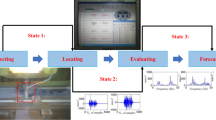Abstract
Aging of structures and infrastructures urges new approaches to ensure higher safety levels without service interruptions. Structural health monitoring (SHM) aims to cope with this need by processing the data continuously acquired by pervasive sensor networks, handled as vibration recordings. Damage diagnosis of a structure consists of detecting, localizing, and quantifying any relevant state of damage. Deep learning (DL) can provide an effective framework for data processing, regression, and classification tasks used for the aforementioned damage diagnosis purposes. Within this framework, we propose an approach that exploits a deep convolutional neural network (NN) architecture. The training of the NN is carried out by exploiting a dataset, numerically built through a physics-based model of the structure to be monitored. Parametric model order reduction (MOR) techniques are then exploited to reduce the computational burden related to the dataset construction. Within the proposed approach, whenever a damage state is detected, the physical model of the structure is adaptively updated, and the dataset is enriched to retrain the NN, allowing for the previously detected damage state as the new baseline.
Access this chapter
Tax calculation will be finalised at checkout
Purchases are for personal use only
Similar content being viewed by others
References
Bigoni C, Hesthaven JS (2020) Simulation-based anomaly detection and damage localization: an application to structural health monitoring. Comput Methods Appl Mech Eng 363:112896. https://doi.org/10.1016/j.cma.2020.112896
Bigoni C, Zhang Z, Hesthaven JS (2020) Systematic sensor placement for structural anomaly detection in the absence of damaged states. Comput Methods Appl Mech Eng 371:113315. https://doi.org/10.1016/j.cma.2020.113315
Bishop CM (1994) Mixture density networks. Aston University
Bull L, Worden K, Dervilis N (2020) Towards semi-supervised and probabilistic classification in structural health monitoring. Mech Syst Signal Process 140:106653. https://doi.org/10.1016/j.ymssp.2020.106653
Capellari G, Chatzi E, Mariani S (2018) Structural health monitoring sensor network optimization through Bayesian experimental design. ASCE-ASME J Risk Uncertain Eng Syst, Part A: Civ Eng 4(2):04018016. https://doi.org/10.1061/AJRUA6.0000966
Corigliano A, Mariani S (2004) Parameter identification in explicit structural dynamics: performance of the extended Kalman filter. Comput Methods Appl Mech Eng 193(36–38):3807–3835. https://doi.org/10.1016/j.cma.2004.02.003
De S, Britton J, Reynolds M, Skinner R, Jansen K, Doostan A (2020) On transfer learning of neural networks using bi-fidelity data for uncertainty propagation. Int J Uncertain Quantif 10(6):543–573
Doebling SW, Farrar CR, Prime MB, Shevitz DW (1996) Damage identification and health monitoring of structural and mechanical systems from changes in their vibration characteristics: a literature review. Tech Rep LA-13070-MS, Los Alamos National Lab., NM, USA. https://doi.org/10.2172/249299. https://www.osti.gov/biblio/249299
Eftekhar Azam S, Chatzi E, Papadimitriou C (2015) A dual Kalman filter approach for state estimation via output-only acceleration measurements. Mech Syst Signal Process 60–61:866–886. https://doi.org/10.1016/j.ymssp.2015.02.001
Eftekhar Azam S, Mariani S (2018) Online damage detection in structural systems via dynamic inverse analysis: a recursive Bayesian approach. Eng Struct 159:28–45. https://doi.org/10.1016/j.engstruct.2017.12.031
Entezami A, Sarmadi H, Behkamal B, Mariani S (2020) Big data analytics and structural health monitoring: a statistical pattern recognition-based approach. Sensors 20(8):2328. https://doi.org/10.3390/s20082328
Farrar C, Worden K (2013) Structural health monitoring: a machine learning perspective. Wiley, Hoboken. https://doi.org/10.1002/9781118443118
Goodfellow I, Bengio Y, Courville A (2016) Deep learning. MIT Press. http://www.deeplearningbook.org
Munir M, Siddiqui SA, Dengel A, Ahmed S (2019) DeepAnT: a deep learning approach for unsupervised anomaly detection in time series. IEEE Access 7:1991–2005. https://doi.org/10.1109/ACCESS.2018.2886457
Pandey A, Biswas M (1994) Damage detection in structures using changes in flexibility. J Sound Vib 169(1):3–17. https://doi.org/10.1006/jsvi.1994.1002
Quarteroni A, Manzoni A, Negri F (2015) Reduced basis methods for partial differential equations: an introduction. Unitext, vol 92. Springer, Berlin
Rafiei MH, Adeli H (2018) A novel unsupervised deep learning model for global and local health condition assessment of structures. Eng Struct 156:598–607. https://doi.org/10.1016/j.engstruct.2017.10.070
Rosafalco L, Manzoni A, Mariani S, Corigliano A (2020) Fully convolutional networks for structural health monitoring through multivariate time series classification. Adv Model Simul Eng Scie 7:38. https://doi.org/10.1186/s40323-020-00174-1
Rosafalco L, Manzoni A, Mariani S, Corigliano A (2021) An autoencoder-based deep learning approach for load identification in structural dynamics. Submitted
Rosafalco L, Torzoni M, Manzoni A, Mariani S, Corigliano A (2021) Online structural health monitoring by model order reduction and deep learning algorithms. Submitted
Rytter A (1993) Vibrational based inspection of civil engineering structures. Ph.D. thesis, University of Aalborg, Denmark
Sohn H, Worden K, Farrar CR (2002) Statistical damage classification under changing environmental and operational conditions. J Intell Mater Syst Struct 13(9):561–574. https://doi.org/10.1106/104538902030904
Sudret B, Defaux G, Pendola M (2007) Stochastic evaluation of the damage length in rc beams submitted to corrosion of reinforcing steel. Civ Eng Environ Syst 24(2):165–178. https://doi.org/10.1080/10286600601159305
Taddei T, Penn J, Yano M, Patera A (2018) Simulation-based classification; a model-order-reduction approach for structural health monitoring. Arch Comput Methods Eng 25(1):23–45
Torzoni M, Rosafalco L, Manzoni A (2020) A combined model-order reduction and deep learning approach for structural health monitoring under varying operational and environmental conditions. Eng Proc 2(1). https://doi.org/10.3390/ecsa-7-08258
Zamir AR, Sax A, Shen W, Guibas LJ, Malik J, Savarese S (2018) Taskonomy: disentangling task transfer learning. In: 2018 IEEE/CVF conference on computer vision and pattern recognition, 18 June–23 June, pp 3712–3722. Salt Lake City, UT. https://doi.org/10.1109/CVPR.2018.00391
Zhang T, Biswal S, Wang Y (2020) Shmnet: condition assessment of bolted connection with beyond human-level performance. Struct Health Monit 19(4):1188–1201. https://doi.org/10.1177/1475921719881237
Acknowledgements
M. T. acknowledges the financial support by Politecnico di Milano through the interdisciplinary Ph.D. Grant “Physics-informed deep learning for structural health monitoring.”
Author information
Authors and Affiliations
Corresponding author
Editor information
Editors and Affiliations
Rights and permissions
Copyright information
© 2022 The Author(s), under exclusive license to Springer Nature Switzerland AG
About this chapter
Cite this chapter
Rosafalco, L., Torzoni, M., Manzoni, A., Mariani, S., Corigliano, A. (2022). A Self-adaptive Hybrid Model/data-Driven Approach to SHM Based on Model Order Reduction and Deep Learning. In: Cury, A., Ribeiro, D., Ubertini, F., Todd, M.D. (eds) Structural Health Monitoring Based on Data Science Techniques. Structural Integrity, vol 21. Springer, Cham. https://doi.org/10.1007/978-3-030-81716-9_8
Download citation
DOI: https://doi.org/10.1007/978-3-030-81716-9_8
Published:
Publisher Name: Springer, Cham
Print ISBN: 978-3-030-81715-2
Online ISBN: 978-3-030-81716-9
eBook Packages: EngineeringEngineering (R0)




